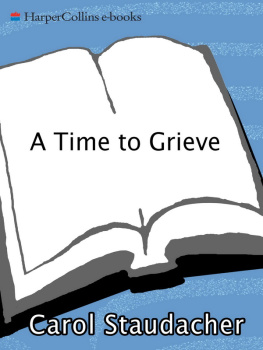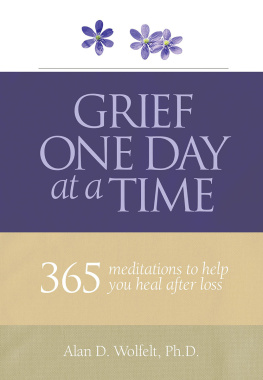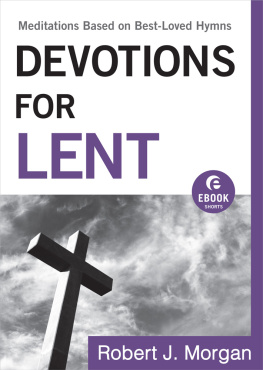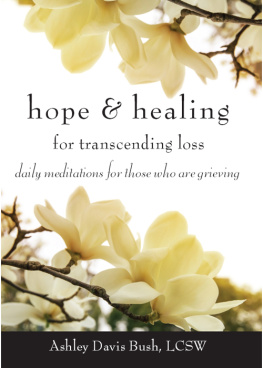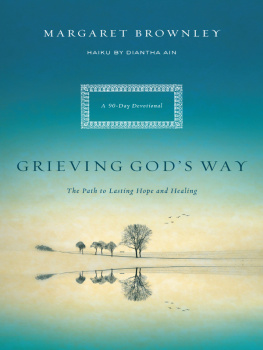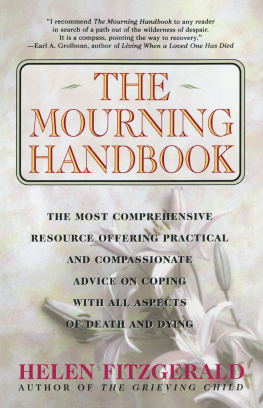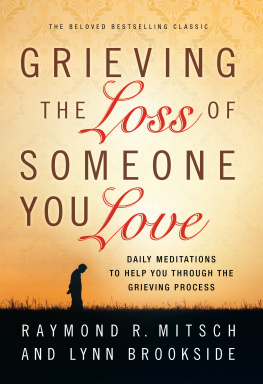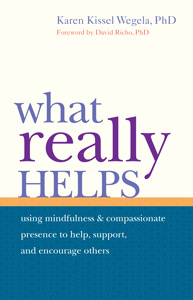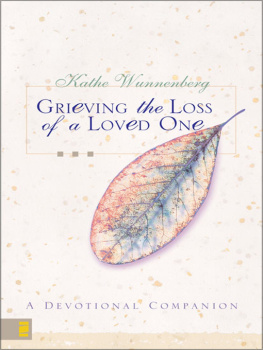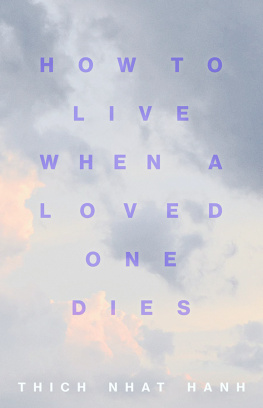A Time to Grieve
Meditations for Healing
After the Death of a Loved One
Carol Staudacher

Dedicated to the memory of my
second mother and father,
Erma M. Crandall and
Robert S. Crandall,
who died as this book was
being written.
This book is for all survivors who are grieving the loss of a loved one, and for those whose loved ones died some time ago but who have not given themselves a lime to grieve.
Contents
Retreating
Working Through
Resolving
T he death of a loved one is, for most of us, the most profound emotional experience we will ever have to endure. Dealing with the deep and prolonged grief that follows such a loss may well be the most painful and disturbing challenge of our lives.
This book accompanies you through this difficult period. The meditations contained in these pages speak to the personal concerns of all survivors. Written to connect with you wherever you are in your grieving process, these meditations are appropriate regardless of when your loved one died. As long as you are still feeling the effects of the lossas long as you are still coping with feelings of sadness, guilt, yearning, anger, confusion, fear, or any of the many other grief-related responsesyou will find meditations here that will speak directly to your experience.
Each page begins with a quote from a survivor who was. like yourself, coping with the death of a loved one. You will find that these survivors' responses and concerns are very similar, if not identical, to your own. For even though each death has its own unique characteristics and each survivor has special circumstances and reactions with which to cope, there is also a wide range of grief responses common to all losses.
You are likely to identify more with some of the survivors statements than with others. Some of the statements may be ones you could have made yourself. You may, for example, feel a kinship with the teacher and surviving mother who said despairingly, Since the death, my whole world has fallen apart. You may echo the questions asked by the middle-aged widower whose wife died of cancer: When will this grief ever end? How long does this go on?
Unfortunately, grief does not have a set schedule. There are no deadlines for the resolution of loss. Instead, the grieving process consists of three broad and overlapping phases: Retreating, Working Through, and Resolving
In Retreating, the first phase immediately following a loved ones death, we experience disbelief, shock, confusion, and dis-orientation, as well as a number of other reactions.
In the second phase, Working Through, we experience the full impact of our loved ones death. We find that we need to cope, on a daily basis, with a variety of feelings, reactions, and conditions that we would never have imagined possible. Our lives begin to undergo change as we grapple with all that the loss means to us and all that it causes us to feel and think and do. This is the most crucial phase of the grieving process, during which our feelings and responses need expression and release. It is a time full of repetition. We tell our stories over and over. We ask ourselves the same questions again and again. We confront longing night after night and day after day. And as we repeatedly experience the same emotions and conditions, we need to talk about them. too. We benefit during this time from seeking and accepting the support of others.
In the final phase, Resolving, we are able to integrate the loss into our lives. We begin to see that we are going to go on, to move forward in our lives. We have days of hopeeven days of excitement and pleasure. This does not mean that we no longer care about or have forgotten our loved ones. It simply means that we have progressed through recognizing the loss, releasing our grief, expressing our sadness and despair and longing, and all the myriad of feelings that result from being a survivor. When a loved ones memory becomes a part of out ongoing lives, that memory will help to sustain us. As one survivor put it after the death of his wife: What I feel now, more than anything, is gratitude, tremendous overwhelming gratitude that I had such a person in my life. After the pain of grief, that gratitude inspires me every day and gives me energy as I reenter the world:
The survivors whose voices provide the inspiration for these pages are people who lost spouses, children, parents, siblings, friends, or lovers. Their loved ones died as the result of illness and disease, accidents, suicide, or murder. These survivors represent a wide range of ages and backgrounds, religions, ethnicities, and occupations. But they all had one experience in common: a sense of profound loss after their loved ones death.
May you gain strength from their voices and the meditations that parallel their concerns. And, as you read, may you gather hope, find the courage to express your thoughts and feelings, persevere through the ongoing release of your grief, and eventually find freedom from emotional pain.
How to Use A Time to Grieve
This book is divided into three sections that correspond to the three broad and fluid phases of grief: Retreating, Working Through, and Resolving. The meditations found within each section present a wide variety of survivors; expressions and an extensive range of topics. Although the topics are arranged to correspond to the grief phases in which they are most likely to occur, the meditations are not meant to be read in any specific order. In other words, this is not the kind of book that should be read progressively, from front to back. To find your starting point, you can consult the topic index or simply skim the survivors; quotes at the top of each page until you see one that speaks to you.
One day, you may find yourself drawn to a certain topic in one section that addresses your needs; the next day, you may see that you are connecting more with a topic in another section of the book. You will find it most rewarding to select meditations that best match the way you;re feeling on any particular day. This book is designed to be used as it suits you best, the way it speaks most directly to your feelings, moods, wishes, dreams, and concerns.
It is the aim of A Time to Grieve to assist you. to be your companion, as you make that difficult but necessary and rewarding journey from coping to healing.
Retreating
I need to keep my mind dear and just think this through.
All great discoveries are made by [people!] whose feelings run ahead of their thinking.
C.H.PARKHURST
S ome survivors try to think their way through grief. That doesnt work. Grief is a releasing process, a discovery process, a healing process. We cannot release or discover or heal by the use of our minds alone. The brain must follow the heart at a respectful distance. It is our hearts that ache when a loved one dies, It is our emotions that are most drastically affected. Certainly the mind suffers, the mind recalls, the mind may plot and plan and wish, but it is the heart that will blaze the trail through the thicket of grief.
Grief is a discovery process. I will open myself to the discoveries my heart and head will make. Grief is a healing journey, and I will trust my heart to lead my head in this journey.
Im afraid to let my feelings go, to grieve. I dont know what will happen to me.
Grief is itself a medicine

